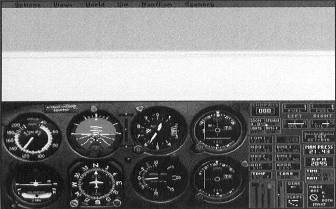Microsoft Flight Simulator Handbook
by Jonathan M. Stern
Straight and Level flight
To maintain straight and level flight at 5,000 feet on a 270° heading, the pilot might use the following scan technique:
|
Figure 12.1 illustrates straight and level flight. For straight and level flight, the altimeter gives the primary indication of pitch performance and the heading indicator gives the primary bank performance information. If the altimeter and heading indicator remain on the same indications, the airplane is flying straight and level. The airspeed indicator gives the primary indication of resultant performance from the power setting except when the airspeed indicator is used as the primary pitch instrument (e.g., constant airspeed climbs). The scan should occasionally encompass the other instruments, which provide a backup and can help identify a problem with one or more of the primary instruments.

In straight and level flight, it is useful to occasionally scan the vertical speed indicator and the turn coordinator as backups to the primary instruments. If the vertical speed indicator showed a 1,000 foot per minute descent when the altitude was holding steady, this would indicate a problem with one of those two instruments. The pilot then could check a third instrument to determine which of the other two was malfunctioning. If the airspeed were normal for the throttle setting and level flight, the pilot might determine that the vertical speed indicator was malfunctioning. On the other hand, if the airspeed were excessive, the pilot may believe that the altimeter was not properly functioning.
Practice flying straight and level now. When the airplane is standing still on the ground, the instrument readings, with the exception of the airspeed indicator, are similar to the instrument readings during straight and level flight (see Figure 12.2).

The attitude indicator shows wings level and level pitch; the altimeter remains constant; the turn coordinator is level; the heading indicator remains constant; and the vertical speed indicator is on 0. (See Figure 12.3.)

Follow these steps:
- Take off in the Cessna from Meigs Field, climb to 5,000 feet, and fly straight and level on a 270° heading. Try using the instrument scan pattern described previously.
- Look at the outside views to correlate them to the instrument readings. Hold down the Shift key and press the 1,2,3,4,6,7,8, and 9 keys on the numeric keypad to select the various outside views.
- Use your controls to deviate somewhat from level bank and pitch, and then use your scan, instrument interpretation skills, and controls to return to straight and level flight at 5,000 feet on your 270° heading. When you feel comfortable with straight and level flight, pause the simulation and continue reading.
Table of Contents
Previous Section: The Four fundamentals
Next Section: Turns
